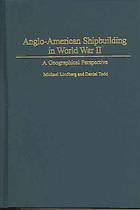
Anglo-American shipbuilding in World War II : a geographical perspective PDF
Preview Anglo-American shipbuilding in World War II : a geographical perspective
Anglo-American Shipbuilding in World War II Anglo-American Shipbuilding in World War II A Geographical Perspective Michael Lindberg and Daniel Todd Westport, Connecticut London Library of Congress Cataloging-in-Publication Data Lindberg, Michael. Anglo-American shipbuilding in World War II : a geographical perspective / Michael Lindberg and Daniel Todd. p. cm. Includes bibliographical references and index. ISBN 0–275–97924–5 (alk. paper) 1. Shipbuilding industry—Great Britain—History—20th century. 2. Shipbuilding industry—United States—History—20th century. 3. World War, 1939–1945—Great Britain. 4. World War, 1939–1945—United States. I. Todd, Daniel. II. Title. VM299.7.G7L56 2004 388.4'762382'0094109044—dc22 2004042287 British Library Cataloguing in Publication Data is available. Copyright © 2004 by Michael Lindberg and Daniel Todd All rights reserved. No portion of this book may be reproduced, by any process or technique, without the express written consent of the publisher. Library of Congress Catalog Card Number: 2004042287 ISBN: 0–275–97924–5 First published in 2004 Praeger Publishers, 88 Post Road West, Westport, CT 06881 An imprint of Greenwood Publishing Group, Inc. www.praeger.com Printed in the United States of America The paper used in this book complies with the Permanent Paper Standard issued by the National Information Standards Organization (Z39.48–1984). 10 9 8 7 6 5 4 3 2 1 For Laddie Jares (who worked at Chicago Bridge and Iron Company’s Seneca, Illinois yard building LSTs during World War II) and all the other shipyard workers, in Britain, Canada, and the United States, who built the ships that helped keep the world free in those dark days. Contents Preface ix Acknowledgments xv Ship Type Designations xvii 1. The Academic Bedrock 1 2. World War I: The First Great Test 37 3. The Interwar Years and the Eve of War 67 4. World War II: The Ultimate Test 95 5. Aftermath: The Legacy of British and American Wartime Shipbuilding Industries 189 Selected Bibliography 209 Index 219 Preface The twentieth century witnessed two of the greatest conflicts in human history, the First and Second World Wars. In each conflict, although on a grander scale in World War II, global war was waged on the land, in the air, and at sea. Entire nations waged war, their citizenry, governments, militaries, and industries. In fact, these wars could not have been waged at all had it not been for the industrial might of the participants to field the massive armies, navies, and air forces involved. Arguably, victory in these two wars was also dependent and perhaps largely the result of one side’s ability to outproduce the other. In this regard, Anglo-American industrial strength was of unquestionable importance and was key to the outcome of each conflict. No more so was this evident than in the ability of Great Britain and the United States to build both the sizable naval forces with which each was able to project power on a global basis and the merchant marine fleets necessary to sustain their joint war effort. It is with this accomplishment that this book is most concerned; that is, the Anglo-American shipbuilding industry of World War I and especially World War II, when it flourished as never before. We examine the shipbuilding efforts of the first, principally in order to shed light on how they led up to the grander achievements involved in the second. Although there is a heavy dose of historical review and reflection presented in this work, we actually approach the subject chiefly from a geographical perspective. In other words, our primary focus is examining the spatial distribution (and concentration) of shipbuilding activities in both countries. This, however, is not simply a geographical description or inventory of the locations of shipyards, but a more in-depth analysis of how geography influenced this industry and its spatial distribution. Consideration is given to the various geographical factors that not only impinged upon shipyard locations, but also on the shipbuilding programs of Britain and America during World War II. Of central concern to us, and as a means of effectively dealing with the influence of geography on the Anglo-American shipbuilding industries in that conflict, we apply aspects of the subdiscipline of economic geography to the
